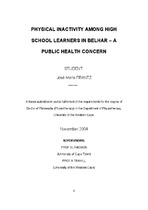| dc.contributor.advisor | Amosun, S.L. | |
| dc.contributor.advisor | Travill, Andre | |
| dc.contributor.author | Frantz, José Merle | |
| dc.contributor.other | Dept. of Physiotherapy | |
| dc.contributor.other | Faculty of Community and Health Sciences | |
| dc.date.accessioned | 2013-06-21T12:04:21Z | |
| dc.date.available | 2007/03/23 10:58 | |
| dc.date.available | 2007/03/23 | |
| dc.date.available | 2013-06-21T12:04:21Z | |
| dc.date.issued | 2004 | |
| dc.identifier.uri | http://hdl.handle.net/11394/1561 | |
| dc.description | Philosophiae Doctor - PhD | en_US |
| dc.description.abstract | For many decades, the World Health Organisation had highlighted the growing importance of chronic non-communicable diseases in developed and developing countries, with an increase in lifestyle-related diseases. Physical inactivity has been identified as one of the risk factors, in addition to other leading risk factors like diet, and the use of tobacco and alcohol, contributing to the occurrence of non-communicable diseases like cardiovascular diseases, cancers, obesity and type 2 diabetes mellitus. Based on the researcher's observations while living in Belhar community for more then ten years, it was hypothesized that the level of physical inactivity among adolescents could become a public health problem in the future if not addressed immediately. | en_US |
| dc.language.iso | en | en_US |
| dc.publisher | University of the Western Cape | en_US |
| dc.subject | Youth | en_US |
| dc.subject | Health and hygiene | en_US |
| dc.subject | South Africa Western Cape | en_US |
| dc.subject | Belhar | en_US |
| dc.subject | Physical fitness for youth | en_US |
| dc.subject | Exercise | en_US |
| dc.subject | Physiological aspects | en_US |
| dc.subject | Health aspects | en_US |
| dc.title | Physical inactivity among high school learners in Belhar - a public health concern | en_US |
| dc.type | Thesis | en_US |
| dc.rights.holder | University of the Western Cape | en_US |
| dc.description.country | South Africa | |

